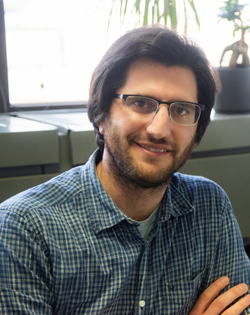
San Raffaele Telethon Institute for Gene Therapy
Vector Engineering and In vivo Tumor Targeting

Our group is driven by curiosity, innovation and science. Our goal is designing, producing and employing innovative tools that can be harnessed in vivo, i.e. through a single and well tolerated systemic dose, to genetically engineer target cells. We have a strong focus in targeting immune cells, especially in the context of chronic diseases and cancer, using metastases as our main disease model. Our research spans the development of gene transfer platforms to reach specific cell types, the in silico design and optimization of therapeutic payloads, and preclinical testing in models that faithfully recapitulate human disease.
Research Activity
Development of gene transfer platforms to target immune cells - We develop and optimize advanced gene delivery systems, such as lentiviral vectors, to enable the precise genetic engineering of selected cell populations directly in vivo. Our efforts are dedicated to designing vectors that combine high efficiency, target specificity, and minimal toxicity, ensuring robust therapeutic performance while maintaining safety. A major objective of our work is the genetic engineering of immune cells, including monocytes, macrophages, and lymphocytes, which are key players in chronic inflammation, immune surveillance, and cancer. By fine-tuning vector tropism and regulatory elements, we aim to expand the scope and precision of immune cell-targeted gene therapy.
In silico design and optimization of therapeutic payloads - We harness computational biology and synthetic design tools to develop and refine therapeutic payloads with immunomodulatory potential. These include engineered cytokines, non-coding RNAs (e.g., microRNAs), and synthetic gene circuits, which can be tailored for cell-type specificity, controlled expression, and enhanced therapeutic index. For instance, we engineer immune-regulatory cytokines by fusing them with targeting domains or regulatory sequences, thereby enhancing their localization and function in desired tissues while reducing systemic exposure and off-target effects. Our final aim by using this rational design approach is accelerating the development of potent, next-generation immunotherapies.
Preclinical testing in models that faithfully recapitulate human disease - To bridge the gap between discovery and clinical application, we rigorously evaluate our gene therapy tools in preclinical models that closely mirror human disease pathophysiology. Our research relies heavily on mouse models of liver metastases, which provide a relevant context for studying immune evasion and therapeutic resistance in solid tumors. Through these models, we assess gene transfer efficiency, therapeutic efficacy, and immunological impact in vivo. Additionally, we investigate the mechanisms by which tumors escape immune surveillance, and use these insights to iteratively refine our vectors and payloads, with the ultimate goal of developing more effective and durable treatments for cancer and other chronic diseases.
Notaro M, Borghetti M, Bresesti C, Giacca G, Kerzel T, Mercado CM, Beretta S, Monti M, Merelli I, Iaia S, Genua M, Annoni A, Canu T, Cristofori P, Degl’Innocenti S, Sanvito F, Rancoita PMV, Ostuni R, Gregori S, Naldini L, Squadrito ML. In vivo armed macrophages curb liver metastasis through tumor reactive T cell rejuvenation. Nature Communications 2025
Bresesti C, Carito E, Notaro M, Giacca G, Breggion S, Kerzel T, Mercado CM, Beretta S, Monti M, Merelli I, Canu T, Naldini L, Squadrito ML. Reprogramming liver metastasis-associated macrophages towards an anti-tumoral phenotype through enforced miR-342 expression. Cell Reports 2025
Rossari* F, Alvisi* G, Cusimano M, Beretta S, Birocchi F, Ambrosecchia DI, Vitaloni O, Brombin C, Rancoita PMV, Canu T, Orofino G, Annoni A, Gentner B, Squadrito ML, Genua M, Ostuni R, Merelli I, Coltella N, Naldini L. A cross-talk established by tumor-targeted cytokines rescues CAR T cell activity and engages host T cells against glioblastoma in mice Science Translational Medicine; * Equal contribution
Kerzel T, Beretta S, Naldini L, Squadrito ML. VisualZoneR: a computational protocol to identify compartmental zones from single cell spatial transcriptomics using R. STAR Protocols 2024
Giacca G, Naldini L, Squadrito ML. Harnessing lentiviral vectors for in vivo gene therapy of liver metastases. Clinical and Translational Medicine 2024
Banerjee K, Kerzel T, Bekkhus T, de Souza Ferreira S, Wallmann T, Wallerius M, Landwehr LS, Agardy DA, Schauer N, Malmerfeldt A, Bergh J, Bartish M, Hartman J, Östman A, Squadrito ML#, Rolny C#. VEGF-C expression in TAMs rewires the metastatic fate of breast cancer cells. Cell Reports 2023; # Equal contribution
Kerzel T*, Giacca G*, Beretta S, Bresesti C, Notaro M, Scotti GM, Balestrieri C, Canu T, Redegalli M, Pedica F, Genua M, Ostuni R, Kajaste-Rudnitski A, Oshima M, Tonon G, Merelli I, Aldrighetti L, Dellabona P, Coltella N, Doglioni C, Rancoita PMV, Sanvito F, Naldini L#, Squadrito ML#. In vivo macrophage engineering reshapes the tumor microenvironment leading to eradication of liver metastases. Cancer Cell 2023; # Shared senior authorship, corresponding authors; * Equal contribution
Delfanti G, Cortesi F, Perini A, Antonini G, Azzimonti L, de Lalla C, Garavaglia C, Squadrito ML, Fedeli M, Consonni M, Sesana S, Re F, Shen H, Dellabona P, Casorati G. TCR-engineered iNKT cells induce robust antitumor response by dual targeting cancer and suppressive myeloid cells. Science Immunology 2022
Keklikoglou I, Cianciaruso C, Güç E, Squadrito ML, Spring LM, Tazzyman S, Lambein L, Poissonnier A, Ferraro GB, Baer C, Cassará A, Guichard A, Iruela-Arispe ML, Lewis CE, Coussens LM, Bardia A, Jain RK, Pollard JW, De Palma M. Chemotherapy elicits pro-metastatic extracellular vesicles in breast cancer models. Nature Cell Biology 2019
Squadrito ML#, Hansen SK, Cianciaruso C, De Palma M#. EVIR: Chimeric receptors that enhance dendritic cell cross-dressing with tumor antigens. Nature Methods 2018





